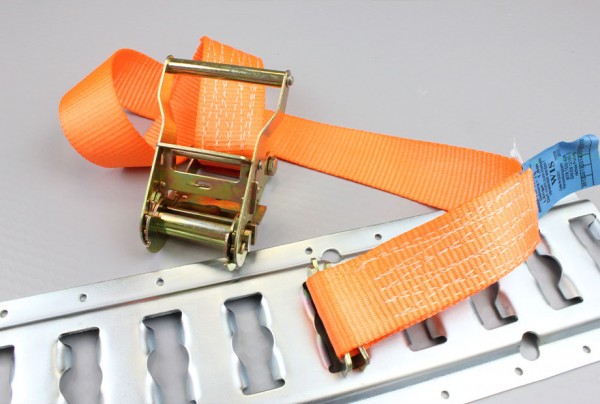Small helpers with a big effect
Tension straps enable the fixation of objects and especially the fastening of transport goods to make them safe for road transport. Tension straps are also helpful tools for private use, for example to secure furniture on the loading area of the trailer when moving house. However, for their general use and for the purpose of cargo securing, some safety-relevant aspects must be observed. Careless procedures when securing the objects to be transported sometimes result in traffic accidents with people being injured and property damaged. An explanation of how to handle lashing straps carefully and professionally is given below.
Two-part and single-part tension straps for cargo securing
There are two-part and single-part tension straps. The former are in particular used for the safe securing of goods in trucks and transporters (recommended if lashing tracks are available). They consist of a strap, a tensioning element (usually a ratchet) and an end fitting (often a hook or ring). The tensioning element is used to create the necessary clamping force. In addition, a mandatory label on both sides of the strap indicates the maximum permissible lashing force.
Single-part tension straps, on the other hand, do not have an end fitting, only a tensioning element (clamping lock or ratchet) and a strap. They are mainly used to realise a flush fixation of goods. One very common area of application is the enclosure of parcels and the closing of suitcases.
Checking the functionality
Before a tension strap is used, a visual inspection is carried out. This includes the inspection of the label and also the check for damage to the belt. This ensures that the belt is still fit for use.
Tension straps do not have a general expiry date or a guideline usage period. This means that it must be checked that they are in a sound condition before use. Signs such as damage to the seams, tears over 10 per cent of the belt width, an illegible identification label or a damaged tensioning element indicate that the strap needs to be discarded. Use is then prohibited. In addition, ratchets and hooks should be disposed of immediately if they are corroded, cracked or deformed.
Using lashing straps
The single-part lashing strap with ratchet is looped completely around the object that is to be transported or secured. Make sure that the structure of the strap is correct. It must not be twisted. The ratchet is then opened by hand and the long end of the strap is passed through the slot in the core of the ratchet. The flat side of the ratchet points in the direction of the object to be fixed.
The belt is passed through until it is under tension with moderate pressure. Excess pressure should never be tolerated. This means that the belt must not be completely taut.
The handle of the ratchet lashing strap is then moved up and down several times by hand. This provides the necessary tensioning force of the belt. The tension strap is then closed using the ratchet until the locking latch engages.
In contrast, two-part tension straps are used in a slightly modified way. They consist of two belts, one short and one long. The long part only has an end fitting. This normally takes the form of a hook. The short strap consists of a tensioning element (ratchet) and hook (end fitting). The hooks are specifically designed for attachment to an eyelet or anchorage points. They are excellent for attaching to trailers that already have these features.
In contrast to the single-part lashing strap with ratchet, the end fittings are first connected to the anchorage points (for example, the hooks are inserted into the eyelets). The straps must rest on the object to be secured depending on the securing technique, for example tie-down lashing. This is followed by the steps already described above.
To release the tension straps, remove the locking latch. For a lashing strap, this enables the strap to move. As soon as it has been opened to 180 degrees, the tensionless belt can be pulled out of the core of the ratchet.
Optimum cargo securing
Cargo securing and the associated application of the securing equipment is a challenging problem area. Tension straps enable optimum cargo securing, however, particularly in combination with accessories such as the anti-slip mat or lashing tracks.










